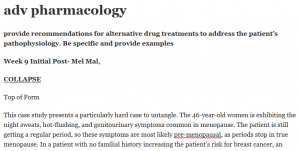adv pharmacology

provide recommendations for alternative drug treatments to address the patient’s pathophysiology. Be specific and provide examples
Week 9 Initial Post- Mel Mal,
Top of Form
This case study presents a particularly hard case to untangle. The 46-year-old women is exhibiting the night sweats, hot-flushing, and genitourinary symptoms common in menopause. The patient is still getting a regular period, so these symptoms are most likely pre-menopausal, as periods stop in true menopause. In a patient with no familial history increasing the patient’s risk for breast cancer, an estrogen or combination estrogen/progestin therapy would most likely be initiated (Rosenthal et al. 2021). This therapy would likely reduce the uncomfortable symptoms, however in a patient with a family history of breast cancer, the therapy can increase the likelihood of breast cancer occurrence.
Luciano et al., found that both estrogen therapies and combined estrogen/progestin therapies increased the risk for breast cancer (2020). It is important to notice that this study notes that the risks for patients who take the therapy on a short-term basis are at a slightly lower risk, however this patient is young at 46 years old and would possibly need a long-term medication solution.
On the opposite side, Carr summarizes the North American Menopause society’s 2022 updated guidelines on hormonal replacement therapy and explains that a patient with menopausal symptoms can take combined hormone therapy until at least the mean age of menopause (53) without any significant increase in breast cancer (2022). With the newest recommendations, I would recommend that the patient start a combined estrogen and progestin hormone therapy for reduction in symptoms. With this recommendation is the caveat that the patient will need regular visits to re-evaluate the need for the therapy with hopeful cessation of treatment within three to five years to keep any increase in breast cancer risk to a minimum.
The lowest dose medication should be used for the shortest time period in order to reduce comorbidity risk so this patient recommendation will be to start Prempro 0.3mg/1.5mg daily and then reevaluate for effectiveness and need to increase dosage (Rosenthal et al., 2021).
The patient also needs adjustments in her hypertension medication. The patient is currently on Norvasc 10mg daily, and HCTZ 25mg daily. This therapy is within guidelines because she is on Norvasc, a calcium-channel blocker, and Hydrochlorothiazide, a thiazide diuretic, are being used to potentiate each other’s effects. In cases where a thiazide diuretic is ineffective in controlling HTN, a loop diuretic may be added. In this patient, we will recommend adding Furosemide to hopefully control the hypertension. This dosage will start low, at 20mg daily, (taken in the morning to decrease nocturia), with regular home blood pressure checks as well as in office re-evaluation to determine how effective the medication and dosage are (Rosenthal et al., 2021).
This patient would benefit from educational strategies that address medication adherence, as well as lifestyle and nutrition choices. The patient is 230 pounds, which most likely indicates an unhealthy weight. Education on cardio exercises, as well as eating a healthy and balanced diet to help control her weight would be a good starting point. The patient also needs specific education on the importance of taking her medications every day, with explanations that she will not have level and even control of her symptoms and blood pressure if she does not adhere correctly.